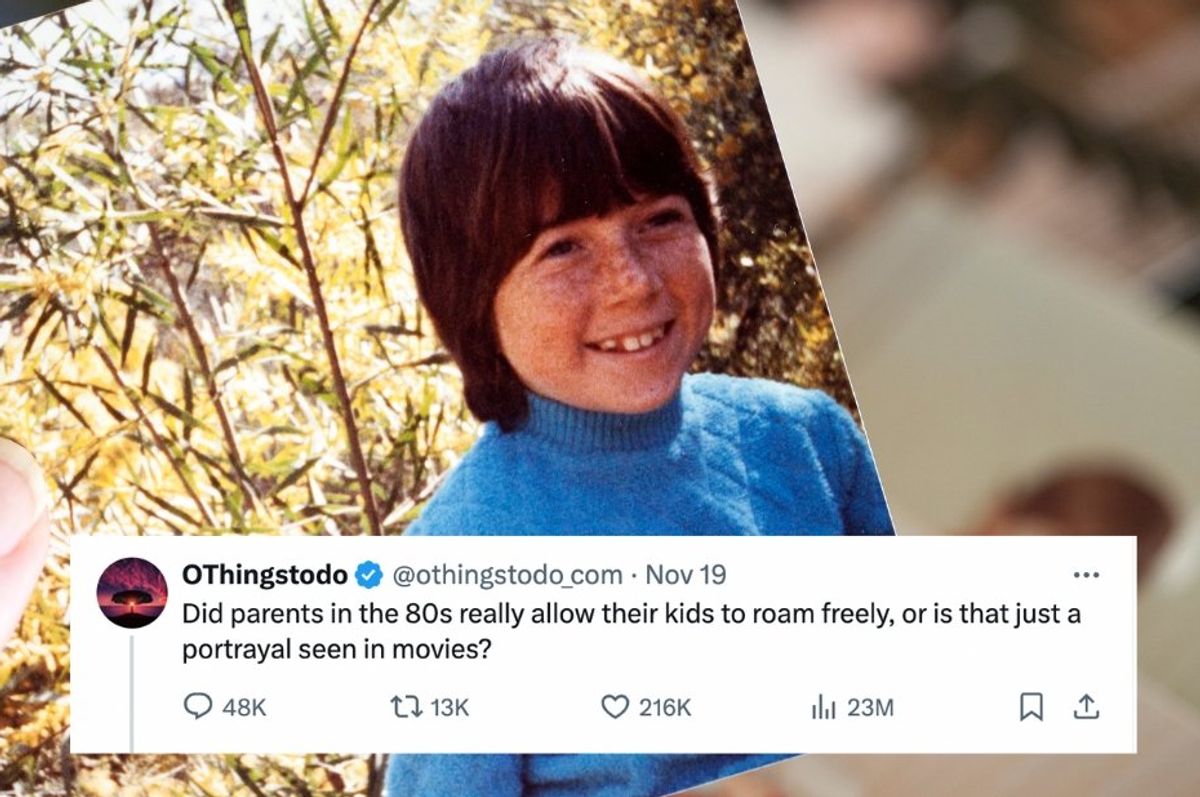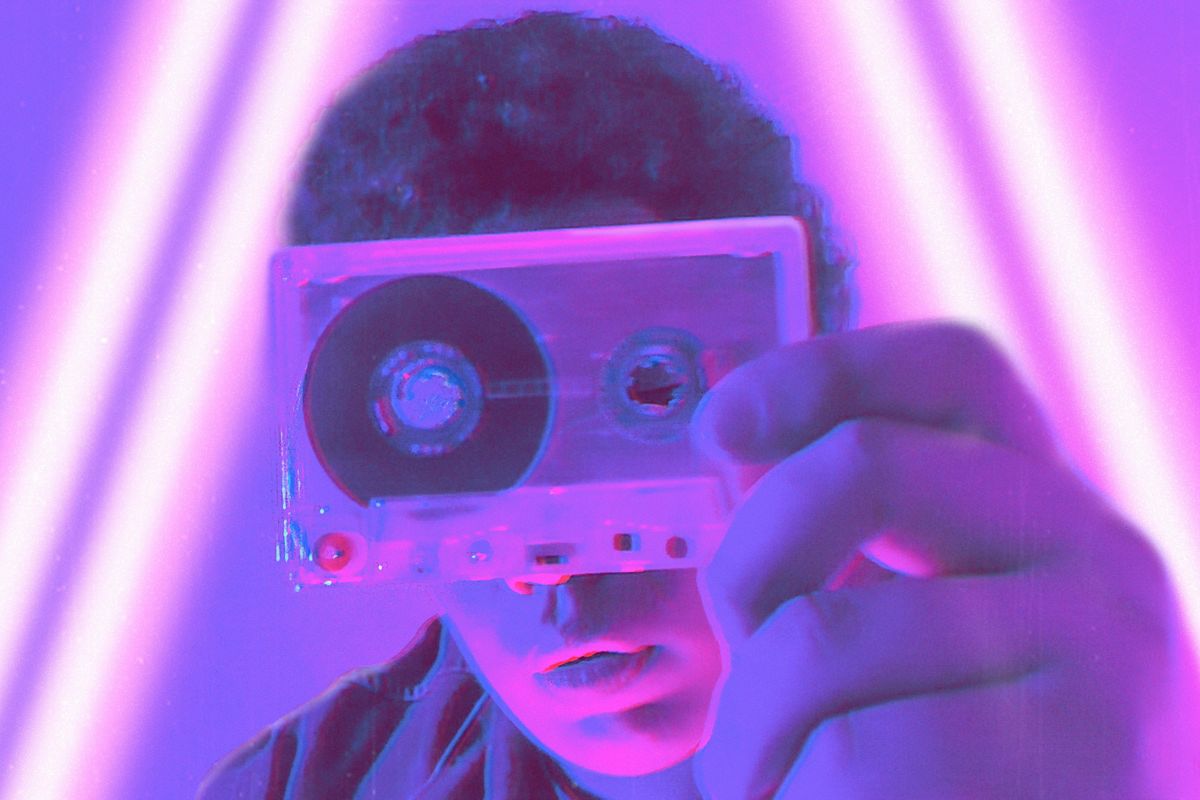Someone asked if 80s kids really 'roamed freely.' After 40,000 answers, the truth is clear.
There is definitely some rose-colored nostalgia in these responses, though.

Were 80s childhoods really as feral as they sound?
Ah, the nostalgia of an 80s childhood. If you've ever watched "The Goonies" or "Stranger Things," you've seen how kids of all ages were largely left to their own devices most of the time, parents playing a background role if any role at all. Children went on unsupervised outdoor adventures for hours upon hours, getting into just enough trouble to learn some lessons but not enough to die (usually).
But is that really what childhood in the 80s was like? Were parents really that hands-off? Did kids really roam around freely like the movies and stereotypes portray? Were people really not worried about what the kids were up to when no one knew where they were and no one had cell phones to check in?
Someone asked that very question and the overwhelming response pointed to a clear answer.
Yes, 80s kids really did have childhoods that are hard to imagine now
"Did parents in the 80s really allow their kids to roam freely, or is that just a portrayal seen in movies?" X user OThingstodo asked. Here are the top responses:
"Really. And it was awesome."
"Facts. We are the generation who raised ourselves. There really was a commercial that came on each night asking parents if they knew where their children were. We survived off hose water & anything we perceived as food. (Berries, fruit trees, etc) We were not allowed to sit inside.. if we tried, we'd get loaded down with chores. We truly were the feral generation.. we took no guts, no glory to new heights & feared absolutely nothing. It was amazing times that still, to this day, bring forth a rush of nostalgia at the smallest memory."
"This is so true. And Sometimes we just got to cook our own TV dinners. And our parents did not constantly have to engage us or make sure we weren’t bored."
"Allowed? We were not allowed in the house during the day. We had bikes and friends. There was 3 rules 1: don't get hurt 2: don't be brought home by the police 3: see that light? If it's on you're late and grounded."
"In the summer it was get home when the streetlights come on. Raised on hose water & neglect. It was glorious."
"I used to roam the sewer drains around town with my friends. Just a handful of us and some flashlights."
"Yep. We rode our bikes all over the place exploring reality. We also had unlicensed lemonade stands, and after we sold out, we’d ride up to the store alone to buy snacks alone. We had our own house keys, we stayed home alone after school, and we cooked for ourselves. No one freaked out about it either."
"We left the house after school and they wouldn’t see us until the street lights came on. Didn’t ask us where we had been or what we did either. We were raised on hose water and neglect in the 70’s and 80’s."
"Well into the 90s. They told us to be home for dinner by ___ or before nightfall. They didn't have a clue where we were or really any way of finding out. This was just the norm. ... then cell phones."
"It’s true. Realize that back then, there weren’t cell phones, video games, 24 hour kids TV, etc. You wanted to be with your friends & that was outside, even in winter. Your bike was your prized possession & while there were bad elements then too, it wasn’t like now. Sad."
That last point, "while there were bad elements then too, it wasn't like now" sentiment came up a lot in the responses. Let's dive into that a bit.
It's easy to look at the past through rose-colored glasses

For the most part, everything people said about those 80s childhoods is true, except this: The world was not safer back then. There weren't fewer "bad elements" and there wasn't less crime.
Around the year 2015, articles started coming out about how children were statistically safer than they'd ever been.
In fact, statistically, the 80s were less safe than now by pretty much every measure. Looking at violent rime statistics from 1960 onward shows that the 80s had significantly higher violent crime rates than we've seen in the 2000s. The idea that Gen X childhoods were carefree with nothing to fear is simply wrong. We just weren't aware of everything there was to fear.
Social media and 24-hour cable news networks put scary things in front of our faces all day every day, giving us a skewed perception of reality. And that's not just conjecture—according to Pew Research, Americans tend to think crime is rising even when it's going down. "In 23 of 27 Gallup surveys conducted since 1993, at least 60% of U.S. adults have said there is more crime nationally than there was the year before, despite the downward trend in crime rates during most of that period."
The folks remembering their free-range childhoods as blissful and safe seem to have forgotten that we started our days pouring milk from cartons that had pictures of missing children on them. A few high-profile abductions and murders of children caused a bit of a missing children panic in the U.S, leading President Reagan to sign the Missing Children Act in 1982 and the Missing Children's Assistance Act in 1984, which founded the National Center for Missing & Exploited Children.
But "high-profile" in the 80s meant a spot on the nightly national news and a headline in a newspaper. Most crimes were only reported locally, there as no "going viral online" and it was easy to avoid scary news if you wanted to. We live in a totally different world today, but not in the way people think. We're safer by nearly every measure, from car accidents to infectious disease to violent crime. But we feel less safe, which directly affects how we parent our children.
There was indeed magic in our blissful ignorance

There's something to be said for being unaware of every bad thing that's happening in the world. We may have been less safe in the 80s in actuality, but not knowing that had its perks.
The question is, can we put the genie back in the bottle? Is it possible to give kids an 80s-style childhood in the age of ubiquitous screens and parents being arrested for letting their tweens walk less than a mile from home by themselves?
Societal expectations of what kids can and should do have changed drastically, as have levels of anxiety and fear in general. Parenting styles have shifted toward more involvement and greater attachment, which isn't bad in and of itself but can be taken to an extreme. The neglectful parenting style of the past wasn't ideal and neither is the overprotective style the pendulum swung to.
If we could somehow find a way to give kids the joy of unstructured outdoor exploration of the 80s and the stronger parent-child connections of the present, we might just hit the sweet spot of raising healthy kids. Perhaps the next generation of parents will figure it out.
This article originally appeared last year.
- Millennial mom asks her own mom about raising a kid in the 80s and is mortified ›
- Those 'carefree' 70s and 80s childhoods weren't the utopia some make them out to be ›
- TikTok dad shares his 80s childhood and it's pure GenX - Upworthy ›
- Abducted boy missing for 7 years rescued after Unsolved Mysteries episode - Upworthy ›
- Adults who lived through the 80s share 15 things pop culture gets wrong about that time - Upworthy ›
- Someone filmed unsupervised young girls and boys for five days and revealed exactly what happened - Upworthy ›
- Girl stops game show host in his tracks as he tries to kiss her - Upworthy ›
- A mom showed her Gen Z kids 'Ferris Bueller' and was surprised who they think the real hero is - Upworthy ›
- Dad makes kids put down their phones then captures hilarious video of them 'playing' outside - Upworthy ›
- Dad shares the hilarious conversations he has with 5-year-old daughter and folks are cracking up - Upworthy ›
- Teacher jokingly challenges 10-year-old to 'find Duran Duran' while in England. She does. - Upworthy ›
- Mom shares her bold decision to parent her kids like it's 1985 - Upworthy ›
- Awkward, grainy video of high school in 1989 is flooding Gen Xers with the happiest memories - Upworthy ›

